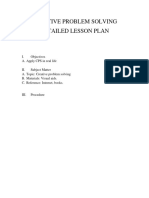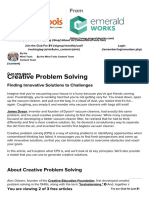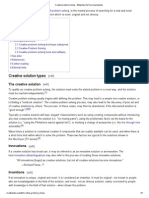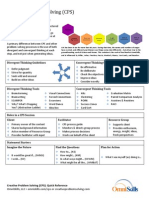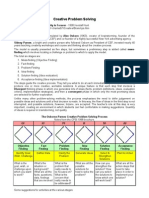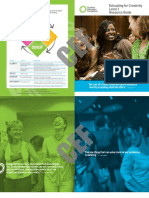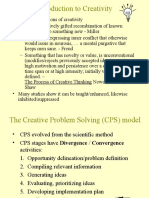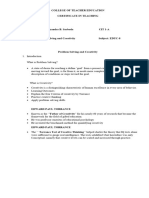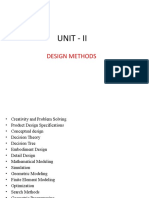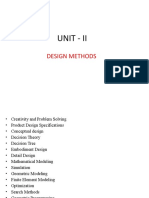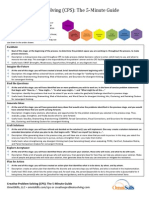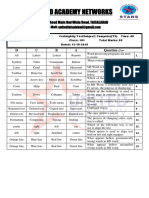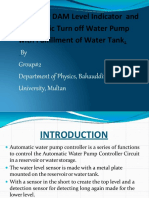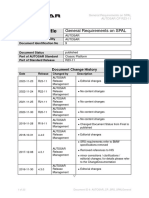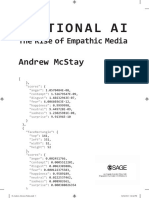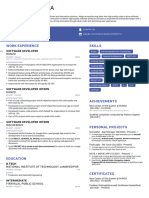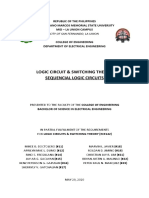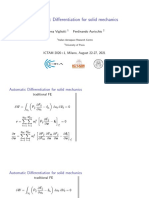CPS: Divergent Tools Quick Reference
Uploaded by
OmniSkills, LLCCPS: Divergent Tools Quick Reference
Uploaded by
OmniSkills, LLCDivergent Tools Quick Reference
Why?
What’s
Stopping
You?
ITF
–
FTQ
Divergent
Thinking
Guidelines
Why:
helps
identify
the
root
of
the
problem,
or
figure
out
the
entire
problem
space
Defer
judgment
How:
begin
with
a
goal,
wish
or
challenge,
and
ask:
"why
do
you
want
this?"
To
the
Strive
for
quantity
response,
ask
again.
When
you
feel
you
have
arrived
at
the
root
of
the
problem,
ask,
Seek
wild
and
unusual
"What's
stopping
you?"
Repeat
the
process
to
its
logical
end.
Build
on
other
ideas
Tips:
try
not
to
go
so
far
as
to
reach
“to
live
a
happy
and
fulfilling
life”
Word Dance FTQ Statement Starters
Why: when stuck, helps to think of the problem statement in new ways Imagine the Future
How: in the problem statement, circle the verb, then generate other verbs that might It would be great if… (IWBGI)
replace it. Then, circle the object or outcome words, and generate possible substitutes. I wish… (IW)
Mix and match the responses. Choose the statement that best expresses the problem. Find the Questions
Tips: unusual and off‐course are OK when generating substitutes
How to… (H2)
Idea Box (mix‐and‐match) GI – CS – PFA How might… (HM)
Why: generate new and original combinations In what ways might… (IWWM)
How: from the challenge statement, select the essential characteristics of the problem, What might be all the… (WMBAT)
and list those on paper as column headings. For each column, list a variety of options. Plan for Action
Then, mix and match, choosing one from each column. What ideas does that
What I see myself (us) doing is…
combination give you? Repeat with different combinations.
Brainwriting ITF – FTQ – GI – CS – PFA Tools by CPS Stage
Why: quiet brainstorming; use with quiet groups, and where some people dominate
Imagine the Future
How: one form per person, extras in a pile. Write three ideas in the first row, put form
on the pile, take another. Read the ideas, write three more in the next row, building on Brainstorming
the existing ideas or adding new ones. Continue until all the boxes are full. Brainwriting
Tips: use brainwriting form with 3x3 boxes, and pre‐populate with 2x2 Post‐its Why? What’s Stopping You?
Excursions
Brainstorming / Stick ‘em Up Brainstorming ITF – FTQ – GI – CS – PFA
Find the Questions
Why: classic tool for generating lots of ideas
How: ideas are said out loud and recorded; Stick ‘em Up: write it, say it, hand it up Brainstorming
Tips: use 3x5 Post‐its; one idea per Post‐It; stick on flip chart sheets; number the Brainwriting
sheets; enhance thinking with SCAMPER, forced or visual connections, excursions Why? What’s Stopping You?
Word Dance
SCAMPER GI – CS
Generate Ideas (low to high novelty)
Why: spur thinking in specific ways, to enhance brainstorming or brainwriting
How: facilitator asks questions from SCAMPER (Substitute, Combine, Adapt, Modify, Idea Box
Put to other uses, Eliminate, Rearrange) sheet. E.g., What can you substitute for it? Brainwriting
What can be combined with it? What can you subtract? What can you add? Brainstorming
Forced Connections GI – CS – PFA SCAMPER
Forced Connections
Why: enhances brainstorming and brainwriting, especially when stuck
Visual Connections
How: facilitator holds up or points to an object unrelated to the problem, and asks:
Excursions
"When you look at this (object), what ideas do you get for solving this problem?"
Craft Solutions
Visual Connections GI – CS – PFA
Why: enhances brainstorming, helps participants relax and incubate Use convergent tools to select from ideas
Use “Generate Ideas” tools to craft and
How: show an image, ask participants to write 3‐5 words suggested by it. Repeat with
strengthen solutions
two more images. Then, ask participants to make a direct connection from the words
they have written to the problem at hand. Explore Acceptance
Tips: use visual connections worksheet Bainstorming (identify assisters, resisters)
Excursions ITF – GI – CS – PFA “Generate Ideas” tools to find ways to use
assisters and overcome resisters
Why: takes people outside the context of the problem to look elsewhere for
inspiration Plan for Action
How: many variations. For example: participants close their eyes while the facilitator Brainstorming (to identify action steps)
talks them through a journey to a specific place, or one of their own imagining. When
they open their eyes, they record ideas that were inspired by the excursion.
Creative
Problem
Solving
(CPS):
Divergent
Tools
Quick
Reference
OmniSkills,
LLC
▪
omniskills.com/cps
or
creativeproblemsolving.com

